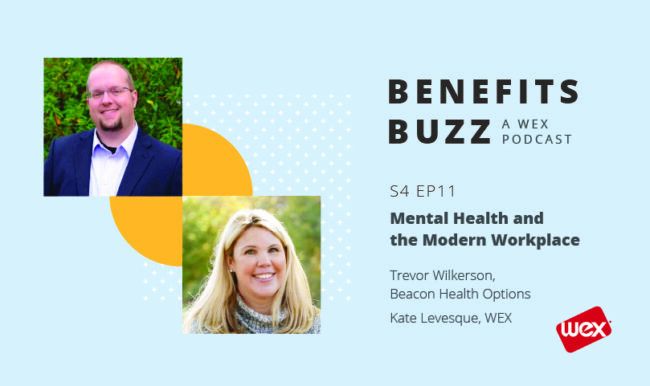Stay connected
Subscribe to our health benefits blog and follow us on social media to receive all our health benefits industry insights.

May is Mental Health Awareness Month. A Kaiser Family Foundation survey found that the percentage of U.S. adults who said worry and stress related to the coronavirus was negatively affecting their mental health increased from 32 percent to 52 percent in just the first few months of the pandemic. The economic downturn coupled with the changes to our work-and-life environment had a profound impact on the wellbeing of Americans.
In our latest episode of Benefits, our hosts discussed mental health and what it means for the modern workplace with Trevor Wilkerson, manager of clinical EAP services at Beacon Health Options, and Kate Levesque, global benefits manager at WEX.
Wilkerson said recent data has shown what many suspected. Increases in depression and anxiety are driving the need for better mental health solutions and greater awareness in this country. Levesque also said that she’s seen increases in enrollment into WEX’s Employee Assistance Program (EAP) and increases in medical/disability claims from employees.
Wilkerson also noted the increased need for support of our frontline workers.
“They haven’t had the luxury of being in a safe place,” Wilkerson said. “They’re faced with those things every day. Our hospital workers, and just what they’re seeing every day, the tireless work they’ve put in.”
As COVID-19 cases drop, the shift in how many employees worked at the start of the pandemic may be here to say. A USA Today survey earlier this year shows that nearly 30 percent of U.S. employees would quit their jobs if they had to return to an office.
Levesque pointed out that WEX has conducted four employee surveys to gauge interest in returning to the office versus working from home. For some employees, being in a work environment where they’re surrounded by people and away from their families and pets creates challenges.
“Companies aren’t making these decisions in silos,” Levesque said. “They are looking at industry. They are taking employee pulse surveys, similar to what WEX has done.”
Whether in-person or on a virtual call, you might be wondering what signals to look for from your colleagues so you can tell when one of them may need increased attention to their mental wellness. Wilkerson also said many employees respect professional boundaries between themselves and their co-workers, supervisors, and direct reports.
“Just look for those changes,” Wilkerson said. “Things are different. Absenteeism is a big one. Not speaking up as much in meetings. Not meeting deadlines. Those subtle changes you might see.”
And there’s one other piece of advice he has: There’s nothing wrong with asking, “Are you OK?”
“Just focus on being a listener and having a little bit of knowledge,” Wilkerson said. “Knowing about the EAP and being able to check back in on that. … When people feel connected, they do better.”
Wilkerson says you should watch for the following symptoms:
To listen to more Benefits episodes, check out our show page or subscribe anywhere you find your favorite podcasts.
The information in this blog post is for educational purposes only. It is not legal or tax advice. For legal or tax advice, you should consult your own counsel.
Subscribe to our health benefits blog and follow us on social media to receive all our health benefits industry insights.